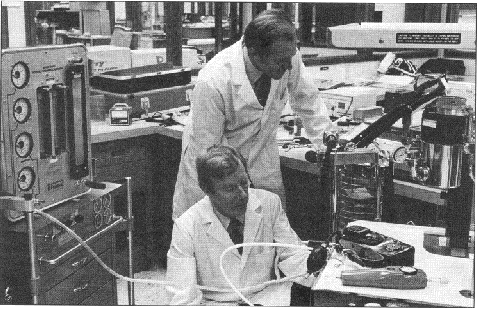
ECRI SCIENTIST Guy Knickerbocker, Ph.D and Robert Spooner, Ph.D. examine and test an anesthesia machine as
part of the on-going study of potential anesthesia equipment hazards
Despite the efforts of many groups, serious anesthesia equipment-related mishaps continue to occur. Anesthesia scavenging systems, vaporizers, breathing circuits, and ventilators have been implicated in patient deaths and injuries and occasional injuries to operating room personnel. When it comes to analyzing the cause of an accident or failure, many questions arise: Was there a device design defect? A random component failure? A manufacturing defect? Faulty maintenance or pre-use inspection? Operator error? Sabotage? Or was injury or death the result of an abnormal or idiosyncratic physiologic response to otherwise normal conditions of use and performance for that device?
ECRI has been answering these questions for nearly two decades. FICRI is a non-profit, tax-exempt research institute located in suburban Philadelphia. To maintain maximum objectivity, neither ECRI nor its staff has a direct or indirect financial interest in the sale of medical devices, and no royalties, gifts, or commissions are accepted from the medical device or hospital equipment industry.
ECRI investigates, analyzes, and helps to prevent anesthesia equipment-related incidents throughout the world. Anesthesia personnel may be familiar with Technology for Anesthesia, an ECRI news-letter that evaluates products, provides device operation recommendations, and reports equipment related hazards. The organization maintains the world’s largest and most up-to-date computer database on medical device problems with more than 60,000 reports on file. Information is derived from a number of sources including medical, legal, engineering, and scientific literature; government reports (U.S. and international); and ECRI’s own clinical and Laboratory research, reporting systems, and detailed forensic investigations.
ECRI’s commitment to safe health care technology and, in particular, anesthesia safety, has contributed to a number of worldwide patient safety initiatives. For example in 1982, ECRI issued its anesthesia system pre-use check , which was extensively tested and reviewed prior to publication. The check list was distributed at the American Association of Nurse Anesthesists annual meeting in 1982, and was subsequently updated in 1984 to include a sample check of vaporizers to detect excessive output. ECRI has also published numerous policies and procedures for inspection, maintenance, and safe and effective use of anesthesia equipment, and has long advocated use of oxygen analyzers. ECRI has conducted many detailed evaluations of equipment used in the anesthesia department, such as EKG monitors, ventilators, capnographs, patient monitoring equipment, and peep valves, the results of which have been published in its journal Health Devices. Standards-issuing organizations, such as the ASTM, have called on ECRI staff for assistance in anesthesia equipment standards development, and medical device manufacturers have modified equipment on the basis of ECRI’s published evaluations, hazard reports, and engineering safety recommendations.
ECRI maintains a vital, ongoing hazard communications link with over 3,000 hospitals through its Health Devices Alerts program, a weekly service that provides abstracts of medical device problems accompanied by action recommendations, procedures, and forms, where appropriate. This program includes not only manufacturer- initiated or FDA reports, but also hazards that are reported by hospitals worldwide, directly to ECRI. All of these reports are verified by ECRI. Through this hazard reporting and communication system, anesthesia personnel remain alert to such problems, and take steps that will eliminate or reduce the risks to patients.
In addition to its Health Devices System, ECRI offers several technology and risk management information services to the health care, legal, and insurance communities. Through ECRI’s Select (TM) program, equipment analysis are also available. They include a detailed examination of the state of the art, reported and potential risks, technical and clinical comparisons, life cycle cost analyses, and recommendations for specific brand name equipment and models.
Ms. Solomon is Program Director, Hospital Ri5k Control, ECM, 5200 Butler Pike; Plymouth Meeting, PA 19462.

